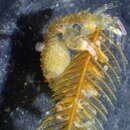en
names in breadcrumbs


Length: 2.7-7.5 mm. Head with median triangular anteriorly pointing spine; rest of body with large blunt paired and unpaired spines dorsally, and laterally on pereonites 2 to 5. (E.g., pereonite 1 with a single dorsal tooth at posterior edge; pereonite 2 with 2 large blunt unpaired teeth median and posterior; pereonite 3 with 3 unpaired teeth; pereonite 4 with anterior pair, median and posterior single blunt teeth; pereonite 6 with 2 pairs blunt teeth; pereonite 7 with 1 pair blunt teeth; pereonites 3 + 4 having antero- and postero- lateral teeth also.) Antenna 1 longer than cephalon plus pereonite 2, flagellum equal to peduncle articles 1 and 2; antenna 2 longer than peduncle of antenna 1, flagellum with short setae. Gnathopod 1 with serrate grasping margin to propodus and dactylus. Gnathopod 2 propodus twice as long as it is broad; palmar surface with proximal anteriorly pointing poison spine and distal triangular or rectangular projection; antero-dorsal surface with tuberculations. Dactylus thick proximally, tapering distally, grasping margin denticulate. Basis attached to middle of pereonite 2, having antero-lateral ridge. Gills round. Pereopods 5 to 7 increasing in length, propodus palm concave, with proximal grasping spines. Female differs in antenna 2 nearly equals antenna 1 in length; gnathopod 2 propodus small, with proximal grasping spine and accessory spine, slight distal projection and evenly tapered dactylus.
California, Oregon, Washington; Japan;
Caprellid, "Ghost" or "Skeleton" shrimps, so called for their skeletal appearance. Amphipod crustaceans, easily distinguished by the elongate stick-like body form and reduction of the abdominal appendages. Head is generally fused with pereonite 1. Pereopods on first 2 segments (pereonites) are most flexible and called gnathopods; gnathopods 2 being the largest, used in defense, feeding and substrate attachment. In many species pereopods 3 and 4 may also be reduced or absent. Gills on pereonites 3 + 4, rarely on pereonite 2. Pereopods 5 - 7 much smaller than 1 + 2, used for clinging to the substratum. In females, brood plates (öostegites) develop on pereonites 3 + 4. Much remains to be learnt about their biology, ecology and in many cases changing distributions.
Found on open coast and in bays, on hydroids, bryozoans, coralline algae, Sargassum, Gelidium, Acanthaster planci
C. angusta, C. incisa and C. verrucosa are all members of the ‘acutifrons’ group, typically similar in their general body shape, the shape and armature of the second gnathopods, and the proportions of the antennae. C. angusta is typically the smoothest, and C. verrucosa with the most extreme large blunt spines. C. incisa can be distinguished from C. verrucosa by its much smaller tuberculations, finely setose antenna 1 and very large propodus and antero-lateral ridge on gnathopod 2. See Laubitz 1970 for table comparing these species.
National Museum of Natural History, Washington DC: (NMNH) 111177; near Mugu pierUSNMC, Point Mugu Calif; May 1962; J McCain; (NMNH) 111178; near Mugu pier USNMC, Point Mugu Calif; 35-50 ft’ ; May 1962; J McCain
Caprella verrucosa is a species of amphipod in the family Caprellidae. It is found in temperate Asia.[1][2][3]
Caprella verrucosa is a species of amphipod in the family Caprellidae. It is found in temperate Asia.